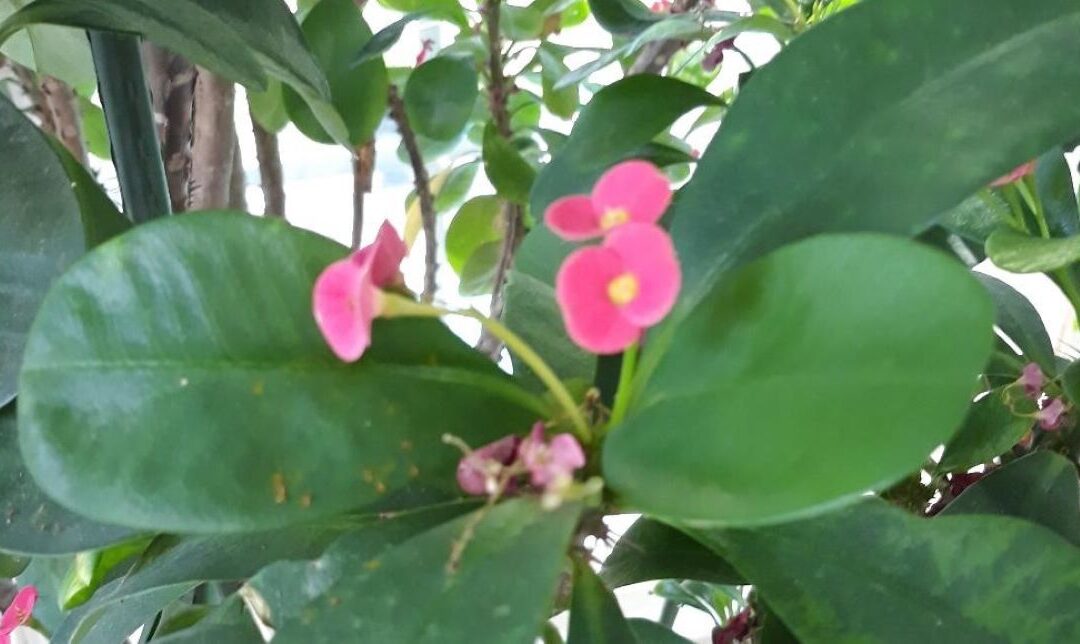My journey with Sonoma Crown of Thorns started as an annual in my butterfly garden about 25 years ago. Of course, being a  tender annual, they bought the farm at the first frost. The next year, I kept them in pots and knew to bring them in before the temperatures got nasty. They have been my botanical companions ever since. They spend about 6 months outside around the pool and then another 6 months in my sunroom. In winter, they get festooned with white lights because it amuses me. In the summer, they act as a botanical screen in front of my filter and heater by the pool. For the entire year, they never stop blooming. While I’m not a big fan of thorny succulents, these plants have won my heart. Now for the specifics: Crown of thorns, also known as Christ plant or Christ thorn, is a flowering plant native to Madagascar, introduced to France in the early nineteenth century by Baron Pierre Bernard Milius, then-governor of Réunion, a region in the western Indian ocean. The crown of thorns is part of the spurge family, or Euphorbiaceae, which contains many different species of succulent plants. Crown of thorns are low maintenance, easily adaptable, and can thrive as an indoor plant or outdoors (in USDA Hardiness Zones 9–11).
tender annual, they bought the farm at the first frost. The next year, I kept them in pots and knew to bring them in before the temperatures got nasty. They have been my botanical companions ever since. They spend about 6 months outside around the pool and then another 6 months in my sunroom. In winter, they get festooned with white lights because it amuses me. In the summer, they act as a botanical screen in front of my filter and heater by the pool. For the entire year, they never stop blooming. While I’m not a big fan of thorny succulents, these plants have won my heart. Now for the specifics: Crown of thorns, also known as Christ plant or Christ thorn, is a flowering plant native to Madagascar, introduced to France in the early nineteenth century by Baron Pierre Bernard Milius, then-governor of Réunion, a region in the western Indian ocean. The crown of thorns is part of the spurge family, or Euphorbiaceae, which contains many different species of succulent plants. Crown of thorns are low maintenance, easily adaptable, and can thrive as an indoor plant or outdoors (in USDA Hardiness Zones 9–11).
Crown of thorn plants have green leaves and small, colorful flowers. This plant also has sharp, spiny stems and branches that excrete a milky sap when broken. If you are considering a crown of thorns as a houseplant, be advised that they have high toxicity and can be poisonous to animals and humans if ingested.
Crown of thorns are neglect-tolerant and require little maintenance. However, when caring for crown of thorns plants, it’s essential to wear gloves, as the latex sap from this plant can cause eye and skin irritation. To keep your crown of thorns thriving, see the steps below:
1. Keep your environment temperate. Crown of thorns plants grow best indoors at a temperature of 65 to 75 degrees Fahrenheit but can tolerate higher or lower extremes.
2. Provide enough sun. Crown of thorns should get full sun for three to four hours every day. Keep your plants in a sunny window where they can receive enough direct sunlight.
3. Avoid overwatering. Only water your crown of thorns when the top inch of soil has dried, and ensure there isn’t any water collecting near the roots. You can wait until the top three inches of the soil have dried before watering in the winter months.
4. Fertilize. Use a liquid fertilizer every few weeks during fall, spring, and summer. When the plant is more dormant in the winter, you can dilute the fertilizer and use it less often.
5. Monitor for pests or fungal diseases. Crown of thorns plants are susceptible to mealybugs, spider mites, and leaf-spotting diseases. You can avoid plant diseases by limiting watering and prevent the emergence of pests by pruning away old or damaged branches that can provide hiding places for destructive insects.
Yes, it has become a major undertaking to transition my botanical buddies inside and outside every year. We are now using a hand truck and wheeling them in and out through the garage. And now these two survivors have a little sibling. Two years ago I found a white crown of thorns. Like his 20+ year old cousins, he started out in a 4 inch pot, and has now graduated to a 10 inch pot. He sits next to and we hope is inspired by his towering brethren. The fact that they flower all year and require very little care is such a big plus. As of now, they come in pink, white and if you can find it the newest color yellow. Is it any wonder the Atlanta Botanical Garden has them in their desert greenhouse.

